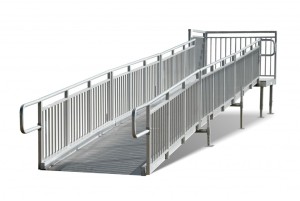The Chicago Department of Transportation is campaigning to install more ADA-compliant ramps around the city. The CDOT’s goal is to make Chicago the country’s most accessible city. The city also has multiple access ramp compliance considerations for schools to follow. Our experts at REDD Team will be there to help you install a new building access ramp that your school can use while working alongside CDOT rules.
What Standards Apply For Ramps In Chicago?

Chicago Building Code standards include multiple rules that CDOT and other organizations require for ramps in schools and other spaces around the city:
- The slope can be between 1:8 and 1:10 if the maximum rise for the ramp is 3 inches. The slope can go from 1:10 to 1:12 if the rise is 6 inches.
- The cross slope for each ramp cannot be any steeper than 1:48.
- Each ramp should be at least 36 inches wide.
- Handrails can appear on the sides of the ramp, but they must be spaced to where the ramp is still 36 inches wide or greater.
- A ramp run can have a rise of up to 30 inches.
- The landings on both ends of the ramp should be at least 60 inches long and as wide as the ramp run. For cases where the landing is on a corner midway through the ramp, the landing should be at least 60 inches on all sides.
Our staff at REDD Team can work along all of these rules for creating school ramps. We custom-manufacture all ramps in the United States based on our clients’ rules.
What about Outdoor Ramps?
Many schools in Chicago will require outdoor ramps. For cases where this is necessary, there should be a light cross slope to keep rain and other items from pooling on the ramp, especially on the landings. Some drainage spots can also appear in some areas provided the rain is redirected toward other places that won’t get in the way of anyone’s path.
Curb Considerations
The curb for a ramp in Chicago should be at least 36 inches wide. The flares on the ends cannot be steeper than 1:10. The curbs next to the ramp flares can also be painted, but the painted space should extend alongside the curb’s flared part.
Level Changes
Sometimes there might be a level change in a ramp due to its placement, but the level change should be minimal:
- A level change of up to ¼-inch can be vertical. This change level is good enough for most situations, as the wheelchair will not be likely to struggle to go over this small shift.
- For cases where the level changes from ¼-inch to ½-inch in height, a slope that is not steeper than 1:2 can help offset this shift. The added slope should allow a wheelchair to go over that level shift.
You can contact us at REDD Team when looking for ADA-compliant building access ramps for your schools in Chicago, IL. We will ensure all ramps we produce meet CDOT and building code standards for accessibility. Contact us on our website or by phone at (800) 648-3696 for more details on how we can help.

